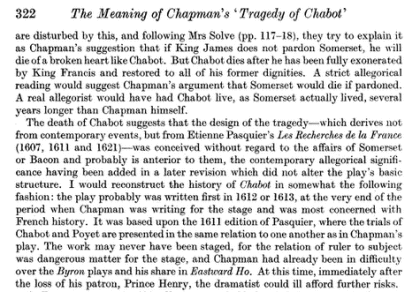Waiting for Chabot Part I
I’ve broken this final installment of the Usher Series into two parts. This post is Part I.
I begin with a reprint of the last post’s final paragraph.
We have arrived at the point where the weight of the evidence says a gentleman usher was involved, somehow, in the Shakespeare Authorship Question. Jonson and Chapman have equally provided repeated clues and information, with many consistent cross-references between them. And yet we know that ethically-challenged scholars beholden to tourist industry stipends will remain unconvinced, claiming randomness, which at this point is their only fall back to this substantial accumulation of evidence. We’ve arrived at this point by following the bread crumb trails laid out by Rambler in Quake-speare Shorterly, that indispensable and extraordinary survey of so many Vere and Shaksper allusions in the literature of Shakespeare’s contemporaries. Now it occurs to me, if we use a different methodology to apply what we now know about gentleman ushers, we could possibly unearth more evidence. And, since such evidence shouldn’t exist, according to the Stratfordian position, the finding of such evidence would disprove their contentions in and of itself. And, if that evidence were particularly persuasive, then it’s a new ball game.
The Six Gentleman Ushers
- Mendice/Bassiolo – Mendice is Alphonso’s implied usher, counterpoint to Bassiolo an usher and Vere character in Chapman’s The Gentleman Usher.
- Poll-Marten – Lady Tub’s usher in Jonson’ A Tale of a Tub.
- D’Olive’s missing usher in Chapman’s Monsieur D’Olive.
- Argus, usher to the widow Countess in Chapman’s The Widow’s Tears.
- Ambler and then De-vile; Lady Tail-bush’s ushers in Jonson’s The Devil is an Ass.
- Amorous La Foole, usher to a Lady in Jonson’s Epicene.
Other characters who are in service that allude to Shaksper.
- Haunce in the anonymously written, Dr. Dodypoll.
- Miles Metaphor in Jonson’s A Tale of a Tub.
- Histrio & Aesop in Jonson’s Poetaster.
- Fly in Jonson’s The New Inn.
With this collected evidence, I decided that a raw Google search on “Gentleman Usher” might bear fruit. And, if it did, that fact would be evidence of the existence of a legitimate Shakespeare Authorship Question. But of course the nature of the evidence would be important. To that end, on St. Crispin’s day last, I began my Google search. I did not search just a few pages deep. I kept going, and going, and going. And I don’t even know how deep it was when I found the topic of today’s post. But its importance was immediately obvious.
My search didn’t completely bring me to new ground. In fact, it brought me back to George Chapman once again. But this time, it was not one of his comedies, but rather a more obscure tragedy, in fact, the last play he wrote. And this gentleman usher reference is contained in the final act of his final play. I’ll start with the circumstances of this play’s publication and topic, as they are possibly dispositive to its importance.
The play is The Tragedy of Chabot. It was authored by Chapman and revised by James Shirley. It first appers in the Master of the Revels accounts in April, 1635, eleven months after Chapman died. It is not registered with the stationers until 1638 and published in 1639. The quarto states is was acted by Queen Henrietta’s Men at the Cockpit theater.
The play is the final of Chapman’s five tragedies based on French history. The first four were written in the 1607-1613 range. Chapman stopped writing plays at that time, depending on when Chabot was written. Scholars agree that the story of Chabot is an allegory for the downfall of the Earl of Somerset, Robert Carr. That event occurred in the early 1620s, placing scholarly consensus for Chabot’s date around 1622.
A dissenting date is proposed by Irving Ribner in “The Meaning of Chapman’s Tragedy of Chabot” (Modern Language Review vol. 55 , 1960 – available on JStor.) Ribner observes that while Chabot is killed in the play, Somerset did not die, and in fact was still living when the play was eventually staged and published. He notes the 1622 date is inconsistent with the prior French history series dates from earlier in that century. Ribner proposed that the play was written between 1612 and 1613, and then shelved, possibly due to censorship problems. The playbook would have belonged to Lady Elizabeth’s company, whom Chapman wrote for. Queen Henrietta’s Men inherited that prior companies playbooks, so Chabot would have moved to that company where Shirley was a resident playwright. Ribner suggests Shirley and Chapman revised the play together, making the allegory topical with its allusions to Somerset. Yet apparently, it remained ‘too hot” for publication until the next decade. The dates of any performances are unknown. Here’s the essential paragraph from Ribner.
The gentleman-usher reference in Chabot occurs in a courtroom scene. It is described specifically as a ‘digression.’ It does not pertain to the main action of the play, except as much of the play is concerned with corruption at the royal court. The Advocate making the argument is expounding on Aristotle’s Corruption and Generation. He is noting how the corruption of one can generate positives in the generation of another. He links a number of these examples together as one begatting another in a biblical style passage. Pay attention to the semi-colons, as they are the breaks that separate the misdirection and filler from content George Chapman has passed down to history. Information that has remained buried until today. Enjoy and savor, and I’ll be back in Part II to unpack the meaning and implications Chabot.
Without further adieu, I present the link to this most remarkable passage. It’s on the left of the page, the speech by the Advocate.
The Tragedy of Chabot – Act V, Sc ii, 13-34
more anon



0 comments
Kick things off by filling out the form below.
Leave a Comment